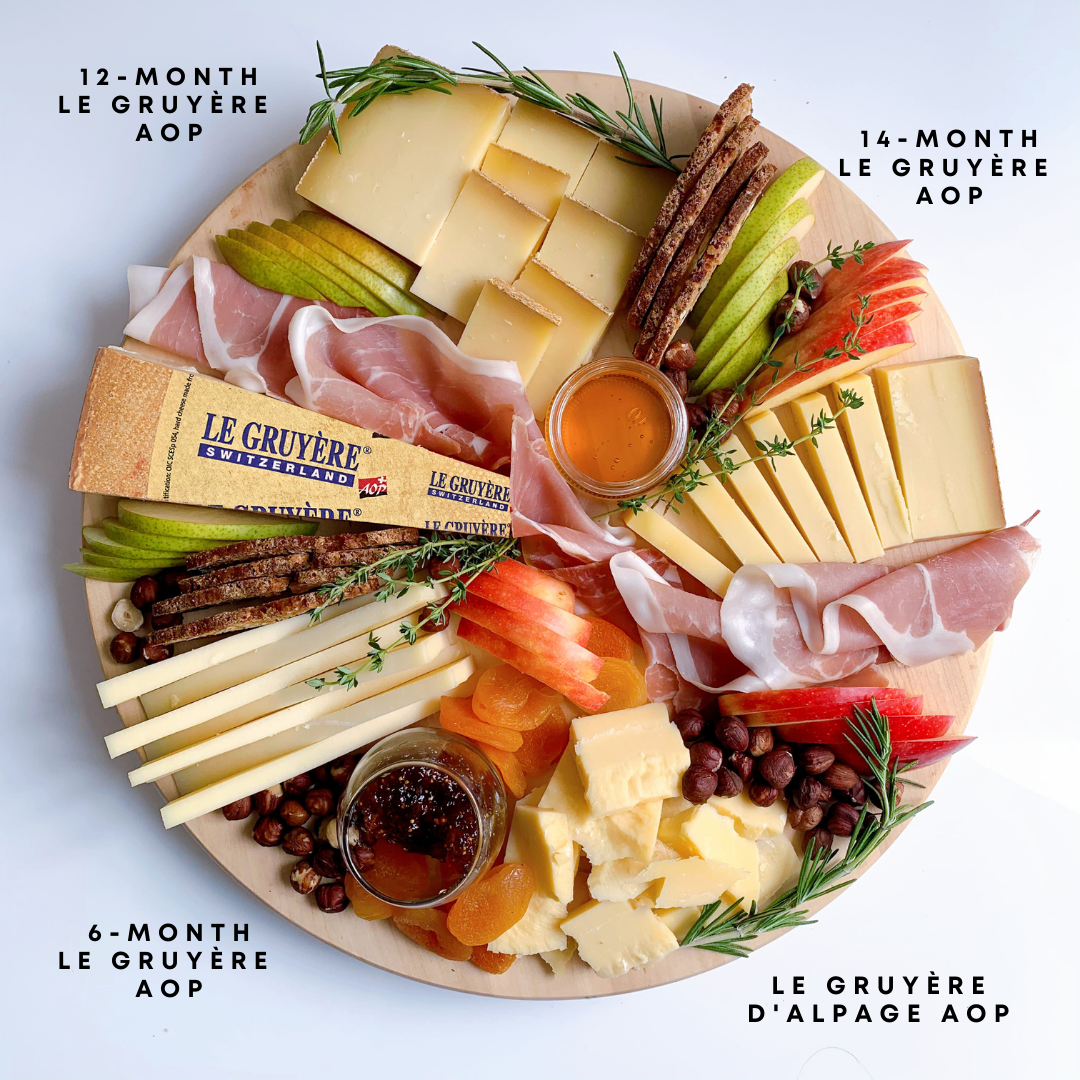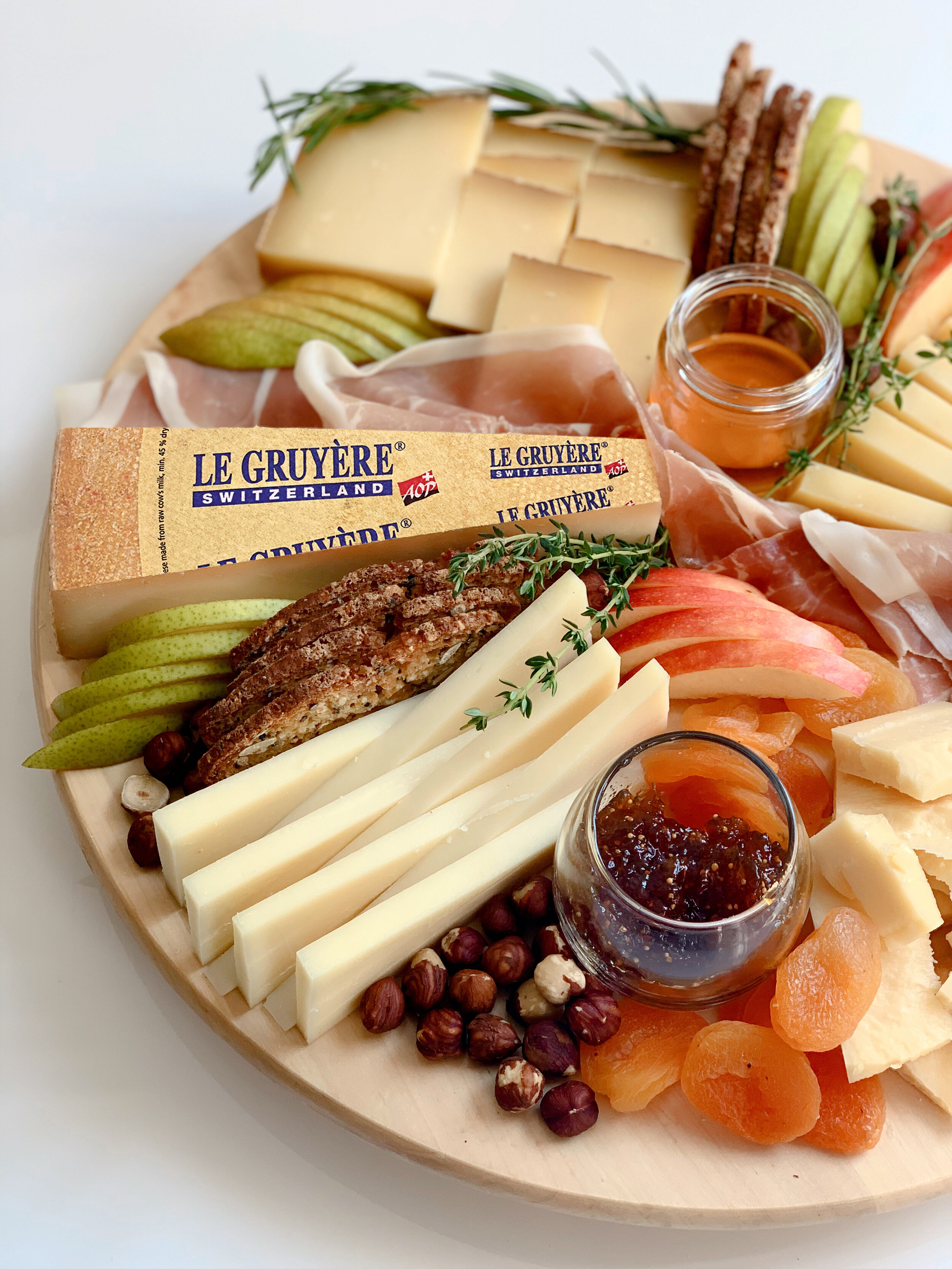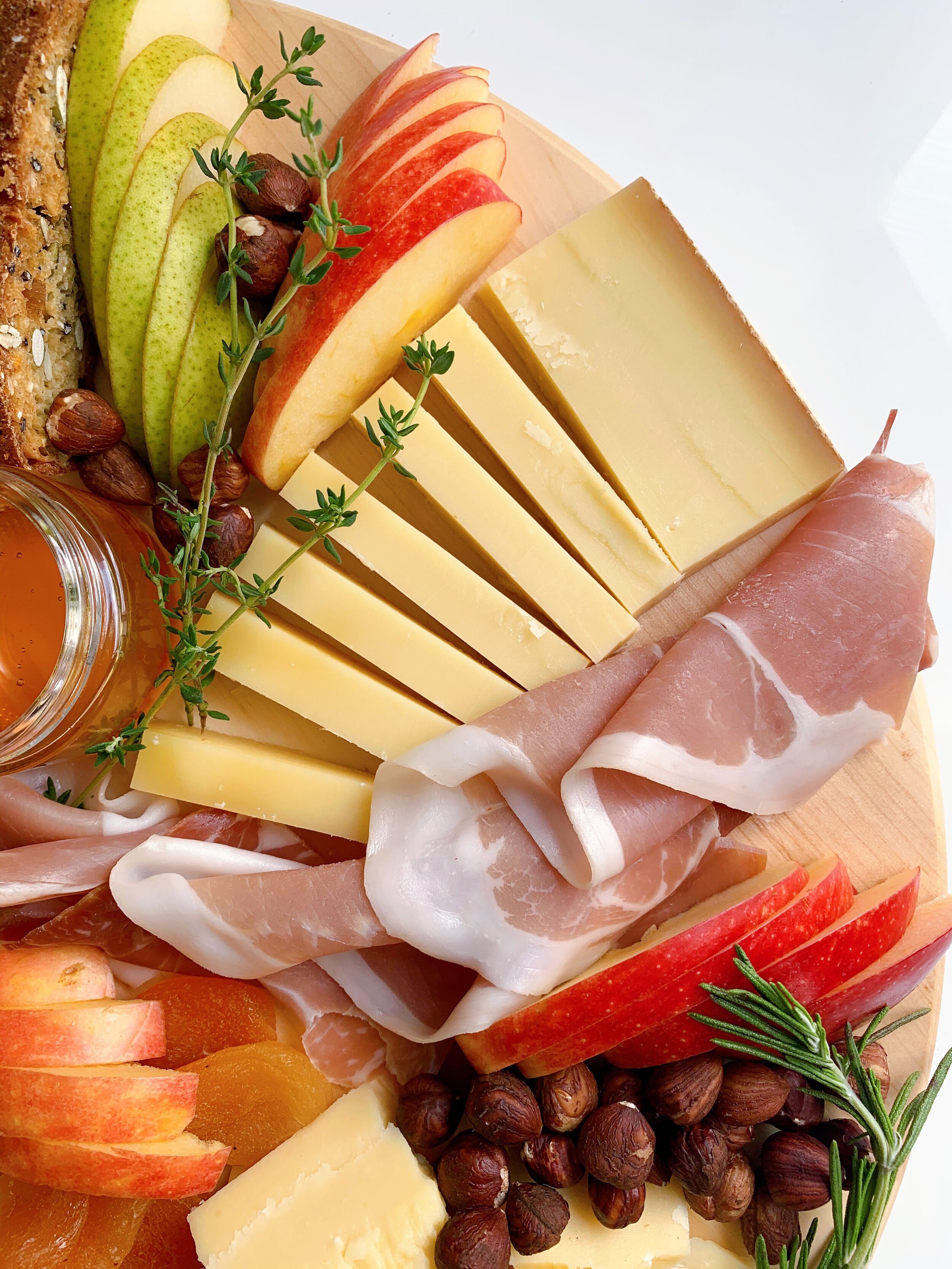That Cheese Plate + Le Gruyère AOP - Plating + Pairing
Le Gruyère AOP is the iconic and beloved cheese of Switzerland.
I’m sure you’ve heard the name before, but did you know that the method of producing Le Gruyère AOP is actually protected in Switzerland? This cheese is made with precision and expertise. No other cheese can be called Le Gruyère AOP if it’s not made in its designated region in western Switzerland region, following the extra-specific methods - from pasture to cow to cheesemaker to affineur - passed down for centuries. You might see a “gruyère” style cheese at the grocery store, but if it’s not called Le Gruyère AOP you are truly missing out on the real deal.
Le Gruyère AOP has over 900 years of history (its tagline is “The Taste of Switzerland since 1115 AD”), and considered a national treasure. Originally, these cheeses were made high up in the Swiss Alps during the summertime in rustic huts. The dairy farmers would graze their animals on fresh grasses and wildflowers while simultaneously producing wheels of cheese. These small huts and adjacent grazing areas are known as “alpage”. Some cheesemakers still practice alpage cheesemaking, and at the end of the summer (late august and into september) these cheesemakers and their animals venture down the mountains to massive celebrations called “désalpes.” I’d love to witness this celebration one day.
I teamed up with Le Gruyère AOP to share some fun recipes and pairings for this delicious cheese! Le Gruyère AOP is a raw cow’s milk cheese. Raw milk cheese is unpasteurized milk - as opposed to pasteurized milk, which is heated and held at a set temperature to stabilize the milk. Heating the milk inherently changes the bacteria and flavors that come from the natural flora the cows are eating, and flavor is paramount to the integrity of Le Gruyère AOP. As the wheels age, different flavors emerge; like fine wine, it grows in complexity. The cows feed on pasture and local hay, so their milk contains the essence of the land. Everything is natural, non-GMO and gluten-free!
PAIRINGS
On this cheese plate, I paired each cheese with accoutrements to highlight or contrast the tasting notes. The special thing about Le Gruyère AOP is that each wheel tastes unique. Depending on the wheel, flavors range from caramelized onions and sauteed mushrooms to pineapple and ripe pears!
6-MONTH LE GRUYÈRE AOP
The first item on my cheese board is Le Gruyère AOP, aged for 6 months. This cheese has an orange rind which is slightly sticky and pungent in smell. Once made, Le Gruyere AOP’s rind is regularly washed with a microbe-rich brine solution called morge. Out of the four wedges I tasted, this cheese was the lightest in color. It had a mild taste, with notes of cooked milk, grass and a slight apple flavor.
I cut the 6-month Le Gruyère AOP into triangle wedges and paired them with pears and fig jam. The pear notes married perfectly with the fruity element of the cheese, while the fig jam added a nice sweetness to bolster the creaminess.
12-MONTH LE GRUYÈRE AOP
Next on the cheese plate is the Le Gruyère AOP aged for 12 months. I was blown away with how different the flavors were from the 6-month old cheese. With six more months of careful aging, the fruity tasting notes that I noticed before morphed into more savory tones. I tasted caramelized onions, broth and roasted meat. The rind on this cheese is a bit darker in color, quite dry and less pungent than the 6-month. The paste of the cheese was almost beige colored, darkening towards the rind. Now I know why this cheese is labelled “Reserve.”
I cut the 12-month Le Gruyère AOP into rectangles and paired them with prosciutto and pears. I wanted to play with the savory notes in the cheese. The prosciutto enhanced those meaty flavors while the pear counter-balanced the salty notes with a fruity, juicy crunch.
14-MONTH LE GRUYÈRE AOP
Next I added the 14-month Le Gruyère AOP to my cheese plate. At this point, I started to notice the trend as the cheese ages. The paste becomes darker, the rind becomes firmer, and tiny crystals begin to form in the paste of the cheese. The crystals in Le Gruyère AOP are one of my favorite elements of this cheese. They occur when the proteins in the milk become crystallized.They provide an interesting crunch and a burst of flavor - what’s not to love? At 14-months, those fruity notes started to come through again. I tasted floral notes, apples and hints of pineapple!
I cut the 14-month Le Gruyère into rectangular cubes and went with a sweet pairing. With honey and apples, the fruity and floral notes of the cheese were beautifully complimented.
LE GRUYÈRE D’ALPAGE AOP
I definitely saved the best for last on my cheese plate. Le Gruyère d'Alpage AOP is one of the most interesting cheeses I’ve tried. This cheese is still made using the historic method of transhumance - when the cheesemakers bring their cows up the mountain for the summer months, making the wheels of cheese in small huts and staying there with them until all return home before the cold weather sets in. This wheel of Le Gruyère d'Alpage AOP page was also 14 months old and was loaded with flavor. I tasted spicy summer grass, cider, more notes of pineapple, toasted hazelnuts followed by slightly funky aftertaste. I closed my eyes and could swear that I heard the clanging of the cow’s bells in the alpine pasture.
The 14-month Le Gruyère d'Alpage AOP had the least amount of moisture, and it gently cracked when I cut into it. With harder cheeses, I like to present them in shards - (uneven, mouthful-sized pieces) which add a rustic look to the cheese plate. I paired the cheese with toasted hazelnuts to bring out nutty notes and dried apricots for a sweet contrast.
How TO Build your plate
While building your cheese plate, make sure you pre-cut your hard cheeses, fold your meat and prep your produce so everything is ready to roll. I added some thyme and rosemary to garnish, as well as crackers for serving! Always add a cracker plate on the side as well for extra crunch. You can follow the Cheese By Numbers method for an easy step-by-step:
Step 1 - Cheese: Le Gruyère AOP 6-Month, Le Gruyère AOP 12-Month, Le Gruyère AOP 14-Month + Le Gruyère d'Alpage AOP 14-M- Spread out your cheeses evenly on the plate and keep each of the distinct - that’s the point!
Step 2 - Meat: Prosciutto. I folded each slice gently to make a “prosciutto river” down the center of the cheese plate
Step 3 - Produce: Apples, Pears and Dried Apricots. I sliced the pears and apples while leaving the apricots whole
Step 4 - Crunch: Hazelnuts and Crackers. I toasted the hazelnuts in the oven at 350F for 15 minutes and added some nice seeded crackers on the plate as well as on the side
Step 5 - Dip: Fig Jam and Honey. Fill in your ramekins with your dips!
Step 6 - Garnish: Rosemary and Thyme. Spread out your herbs evenly on the plate to disperse color.
Lastly, add some labels so you know which cheese is which.
Cheese is more than just a delicious snack to pair with a nice glass of wine. Taking the time to learn about the cheesemaking process and the history of each wheel infuses an extra element of knowledge to share at your next party. I loved learning about where Le Gruyère AOP comes from, how it is made, and its important role in Switzerland’s heritage and recipes. Next time at the grocery store look for Le Gruyère AOP and let me know how you decide to plate it!








